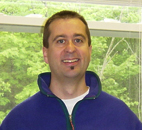Leigh writes
Ittoqqortoormiit
Last night we arrived at Ittoqqortoormiit, a small hunting village at the mouth of Scoresby Sund. From our anchored spot, we could see the dark reds, greens and blues of their houses, and hear the sled dogs barking and whining. In the afternoon we took our life rafts to shore and walked around the village. As soon as we approached land we were bombarded with happy, screaming children all trying to get in our small lifeboat.
Gordon and I spent a few hours walking around the village. Most houses had sled dogs chained out front and meat drying on a rack. It's a bleak village, even in the dead of summer. Historically they are subsistence hunters, surviving on seal, whale, polar bear, musk ox and fish products. The recent changes in sea ice extent and thickness are directly impacting their hunting patterns and survival. The mayor said that their hunting has decreased by ~50% in the past 5 years and that last year they had to import meat to feed their dogs because there was not enough seal meat.
The majority of the village (pop. 500) came aboard the Arctic Sunrise for a tour later in the day. It was a big event for the town, and many villagers took the lifeboat back and forth a few times. The ship became a huge jungle gym - children were running up and down the deck, climbing ladders and jumping down platforms. A few people spoke English, but for the most part we just smiled at each other. Journalists on board recorded testimonials from people about the impact of global warming on their lifestyles. It was incredibly interesting.
Transit
We are now on our way to Zackenberg Research Station, ~250 miles north of Scoresby Sund. The ice is pretty thick, so we are traveling slowly (~ 3 knots). At this rate, we won't be there for 3 more days. We'll spend 3 days there, and then we head back south to Kangerlussuaq Gletscher.
It's difficult to come off four incredible, and incredibly long, days of field work to slow days on the ship. Gordon and I have processed all our GPS data, backed up all of our data and notes, cleaned our equipment and organized it for our next site. Unfortunately we won't be at our next site for another week or two, so we have created a mini-seminar series for ourselves, where we will read and discuss all the articles in the PARCA (NASA's Program for Arctic Regional Climate Assessment) 'Mass Balance of the Greenland Ice Sheet' journal. So far the seminar has succeeded in keeping us busy and productive. When we're not doing that, there are always tasks (cleaning, painting, building, repairing) jobs on the ship to do.


